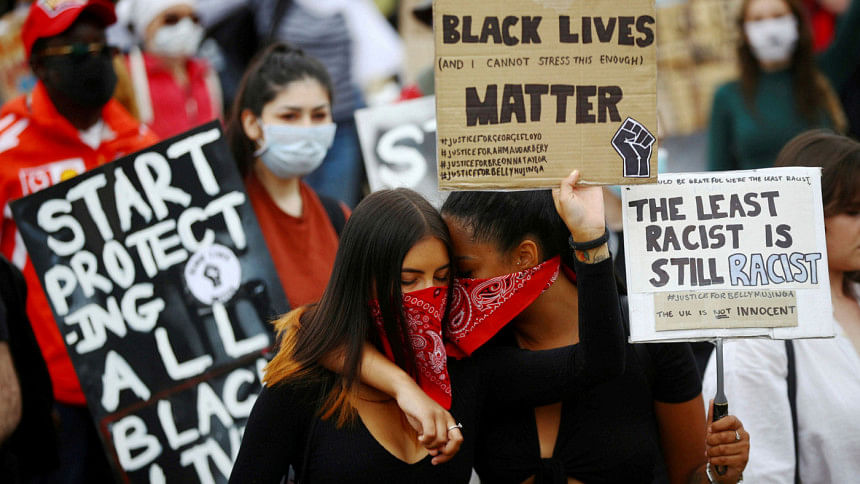Fighting racism: Building coalition among racial minorities

The protests in the wake of George Floyd's murder by four Minneapolis police officers rightfully reflected waves of anger and activism in the United States and beyond. Then, the atrocious incident occurred on August 23 in Kenosha, Wisconsin—where a white police officer shot Jacob Blake, an unarmed African-American man, seven times in front of his kids—proves that the heartbreaking assertion of "I can't breathe, officer!" was not just the plea of Floyd to survive. These words also symbolise historical demands of the black people to be treated fairly and equally in the United States.
In fact, these demands for equal rights extend beyond the United States as well. During the Algerian revolution, Franz Fanon referred to this suffocation in his book Toward the African Revolution: "We revolt simply because, for a variety of reasons, we can no longer breathe." In the recent protests, there have been widespread calls for systemic and structural changes. Cornel West saw signs of hope in a broad coalition of protests in the recent times. The theme that being black should not itself be a death sentence echoed in different parts of the world.
We have seen that different communities of colour as well as white allies participated spontaneously in protests supporting the Black Lives Matter movement. However, in many other communities of colour, there is a lack of consciousness about the historical and systemic injustice against the black people. The recent incidents of discrimination against the black people have pointed out an important but often ignored aspect: the questionable attitude towards the black people among other communities of colour.
The fact that of the four police officers involved in the killing of George Floyd, one was an Asian American, led to some introspective discussions of a complex dynamics of Asian Americans vis-à-vis the black people. Of course, the incident should not lead to a generalised conclusion that all Asian Americans are anti-black, that they do not face discrimination themselves. Especially after the Trump administration's rhetoric of calling the Corona virus "China virus", different types of racist incidents have taken place against Asian Americans. Likewise, there is an urge inside the Hispanic community to confront racial stereotypes. There is a growing call for discussion among South Asians as well to tackle their own anti-blackness. With the rising xenophobic atmosphere against immigrants and Islamophobic incidents, the Hispanic and the South Asian communities are also subject to racial slurs and attacks.
That being said, it cannot be denied that there is a problem of anti-blackness within these communities. It may be uncomfortable for many to admit but being judged by the colour of one's skin happens in many parts of the world. A darker shade of skin can decrease one's likelihood of getting married or having a good job in many countries. Recent discussions of commercial products to whiten the skin and colourism within Bollywood are a glaring example of that.
One essential step towards building progressive coalitions would be to understand the plight of the black people in historical context. Data show that black men are 2.5 times more likely to be killed by the police than white men in the United States. More than eight-in-ten black adults view that they are treated unfairly by the criminal justice system. George Floyd, Breonna Taylor, Ahmaud Arbery, and Elijah McClain are not exceptions—they are the latest additions in the list of black people who have been murdered by the state.
Studies have shown that inequality is not colour-blind. Black people are discriminated against in accessing equal opportunities for education, health, and job. Consequently, the Coronavirus has also hit the black people harder in a lot of US states. Data show that on average the mortality rate among black people are 2.4 times higher than white people in the United States.
Speaking of change, one positive aspect of recent times is that young people from other communities of colour are increasingly showing signs of solidarity by taking part in protests for the Black Lives Matter movement in different ways. The young Asian-Americans are calling for change, while some South Asian groups have also taken active stance in recent times. To make this more sustainable, every conscious individual should make active efforts to bridge any existing gap between them and the black community. Rights that the immigrant communities enjoy today are due to the advances made by the civil rights movement spearheaded by black political activists in the sixties. A multiracial, multi-ethnic movement from below can make the progress truly feasible.
There is a lack of consciousness about the history of the black people in the current education curriculum in the US. One way to redress the situation is that all schools, colleges and universities should offer courses on the history of racism emphasising the plight of the black people. This will help fight anti-blackness in other communities and help remove racial stereotypes. If Germany and South Africa can address their histories of holocaust and apartheid in their education systems, so can the United States to highlight its own records.
Academic departments and educators should make active efforts to incorporate the work of African American writers while reviewing the topics of national history, legal and criminal justice system, and policing related studies in their course design. The black people have voices, but often institutions choose not to hear. Christina Sharpe has brilliantly demonstrated in her book On Blackness and Being how the black people have been denied agency throughout history and how violence against the black people cannot be detached from being black.
Changing anti-black attitude within other minority communities can begin with their leaders' organising public awareness campaigns to get rid of the stigma associated with darker skin colour. International students' associations in different campuses can arrange dialogues and organise activities with the black students' groups. Different solidarity groups can increase their visible support for the black people through real life and social media campaigns.
More deeply, there needs to be honest soul-searching as to why the current national and global structures do not speak for the black people. Achille Mbembe argues in his book Necropolitics that liberal democracy and racism have actually been compatible in the American context. Neoliberal capitalist policies aggravated the plight of the black people in many ways. Academicians and policymakers should look for ways to redress the structural discrimination against the black communities.
These suggestions are not exhaustive, but they can be a stepping stone for building broader coalition of solidarity to address racism in the United States and elsewhere. No nation can progress by putting its minorities in the back seat. Other communities of colour, while fighting their own battles, need to address these biases and build solidarity with all oppressed groups.
Rezwan Masud is a PhD student at the Department of Political Science, University of Colorado Boulder, USA. Haider Khan is a Distinguished Professor, Josef Korbel School of International Studies, University of Denver, USA.

 For all latest news, follow The Daily Star's Google News channel.
For all latest news, follow The Daily Star's Google News channel. 



Comments